Blockchain Technology Implementation in Maersk Shipping Supply Chain
VerifiedAdded on 2023/06/30
|12
|4746
|491
Report
AI Summary
This report provides an analysis of the application of Blockchain technology within supply chain management, focusing on the case of Maersk shipping. It begins by establishing a conceptual framework, highlighting the increasing interest in blockchain due to its decentralised, dispersed, and tamper-proof nature, particularly in the context of Industry 4.0. The problem statement identifies the nascent stage of blockchain utilisation in supply chain management and the need for further examination beyond digital currency applications, emphasizing the growing demand for product tracking systems. The research aims to analyse blockchain's role in Maersk shipping's supply chain, exploring related issues and making future predictions. Key research questions address the impact of blockchain on transparency and trust, the advantages and operational streamlining achieved, and the obstacles encountered during integration. The theoretical framework delves into blockchain technology as a disruptive innovation, its function as a secure and transparent platform for transactions, and its potential to reduce costs, eliminate bottlenecks, and enhance traceability. The report also discusses the maritime supply chain, emphasizing blockchain's capacity for traceability and its potential to improve transaction dependability and efficiency. Finally, the methodological framework briefly touches on the data collection techniques employed in the research.
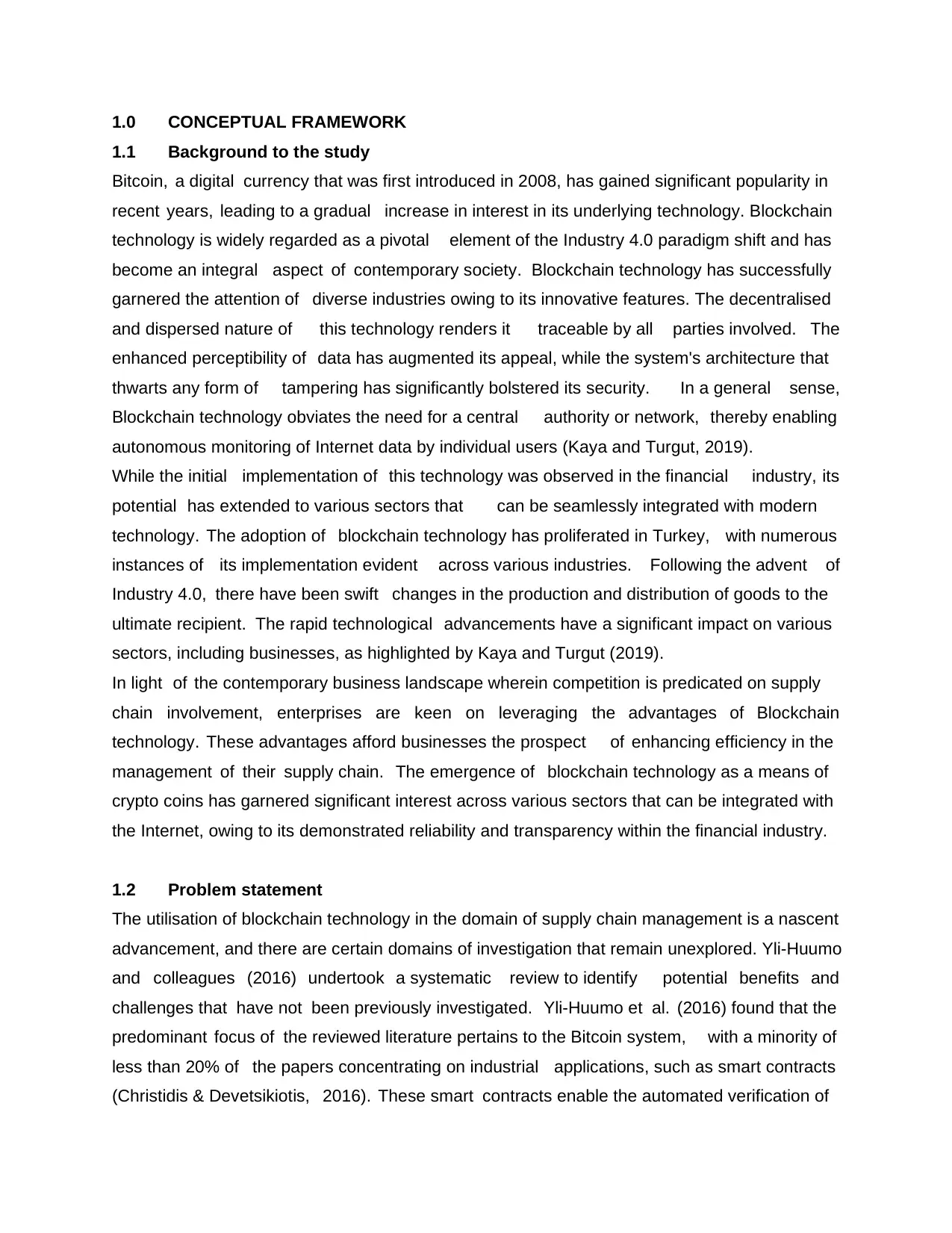
1.0 CONCEPTUAL FRAMEWORK
1.1 Background to the study
Bitcoin, a digital currency that was first introduced in 2008, has gained significant popularity in
recent years, leading to a gradual increase in interest in its underlying technology. Blockchain
technology is widely regarded as a pivotal element of the Industry 4.0 paradigm shift and has
become an integral aspect of contemporary society. Blockchain technology has successfully
garnered the attention of diverse industries owing to its innovative features. The decentralised
and dispersed nature of this technology renders it traceable by all parties involved. The
enhanced perceptibility of data has augmented its appeal, while the system's architecture that
thwarts any form of tampering has significantly bolstered its security. In a general sense,
Blockchain technology obviates the need for a central authority or network, thereby enabling
autonomous monitoring of Internet data by individual users (Kaya and Turgut, 2019).
While the initial implementation of this technology was observed in the financial industry, its
potential has extended to various sectors that can be seamlessly integrated with modern
technology. The adoption of blockchain technology has proliferated in Turkey, with numerous
instances of its implementation evident across various industries. Following the advent of
Industry 4.0, there have been swift changes in the production and distribution of goods to the
ultimate recipient. The rapid technological advancements have a significant impact on various
sectors, including businesses, as highlighted by Kaya and Turgut (2019).
In light of the contemporary business landscape wherein competition is predicated on supply
chain involvement, enterprises are keen on leveraging the advantages of Blockchain
technology. These advantages afford businesses the prospect of enhancing efficiency in the
management of their supply chain. The emergence of blockchain technology as a means of
crypto coins has garnered significant interest across various sectors that can be integrated with
the Internet, owing to its demonstrated reliability and transparency within the financial industry.
1.2 Problem statement
The utilisation of blockchain technology in the domain of supply chain management is a nascent
advancement, and there are certain domains of investigation that remain unexplored. Yli-Huumo
and colleagues (2016) undertook a systematic review to identify potential benefits and
challenges that have not been previously investigated. Yli-Huumo et al. (2016) found that the
predominant focus of the reviewed literature pertains to the Bitcoin system, with a minority of
less than 20% of the papers concentrating on industrial applications, such as smart contracts
(Christidis & Devetsikiotis, 2016). These smart contracts enable the automated verification of
1.1 Background to the study
Bitcoin, a digital currency that was first introduced in 2008, has gained significant popularity in
recent years, leading to a gradual increase in interest in its underlying technology. Blockchain
technology is widely regarded as a pivotal element of the Industry 4.0 paradigm shift and has
become an integral aspect of contemporary society. Blockchain technology has successfully
garnered the attention of diverse industries owing to its innovative features. The decentralised
and dispersed nature of this technology renders it traceable by all parties involved. The
enhanced perceptibility of data has augmented its appeal, while the system's architecture that
thwarts any form of tampering has significantly bolstered its security. In a general sense,
Blockchain technology obviates the need for a central authority or network, thereby enabling
autonomous monitoring of Internet data by individual users (Kaya and Turgut, 2019).
While the initial implementation of this technology was observed in the financial industry, its
potential has extended to various sectors that can be seamlessly integrated with modern
technology. The adoption of blockchain technology has proliferated in Turkey, with numerous
instances of its implementation evident across various industries. Following the advent of
Industry 4.0, there have been swift changes in the production and distribution of goods to the
ultimate recipient. The rapid technological advancements have a significant impact on various
sectors, including businesses, as highlighted by Kaya and Turgut (2019).
In light of the contemporary business landscape wherein competition is predicated on supply
chain involvement, enterprises are keen on leveraging the advantages of Blockchain
technology. These advantages afford businesses the prospect of enhancing efficiency in the
management of their supply chain. The emergence of blockchain technology as a means of
crypto coins has garnered significant interest across various sectors that can be integrated with
the Internet, owing to its demonstrated reliability and transparency within the financial industry.
1.2 Problem statement
The utilisation of blockchain technology in the domain of supply chain management is a nascent
advancement, and there are certain domains of investigation that remain unexplored. Yli-Huumo
and colleagues (2016) undertook a systematic review to identify potential benefits and
challenges that have not been previously investigated. Yli-Huumo et al. (2016) found that the
predominant focus of the reviewed literature pertains to the Bitcoin system, with a minority of
less than 20% of the papers concentrating on industrial applications, such as smart contracts
(Christidis & Devetsikiotis, 2016). These smart contracts enable the automated verification of
Paraphrase This Document
Need a fresh take? Get an instant paraphrase of this document with our AI Paraphraser
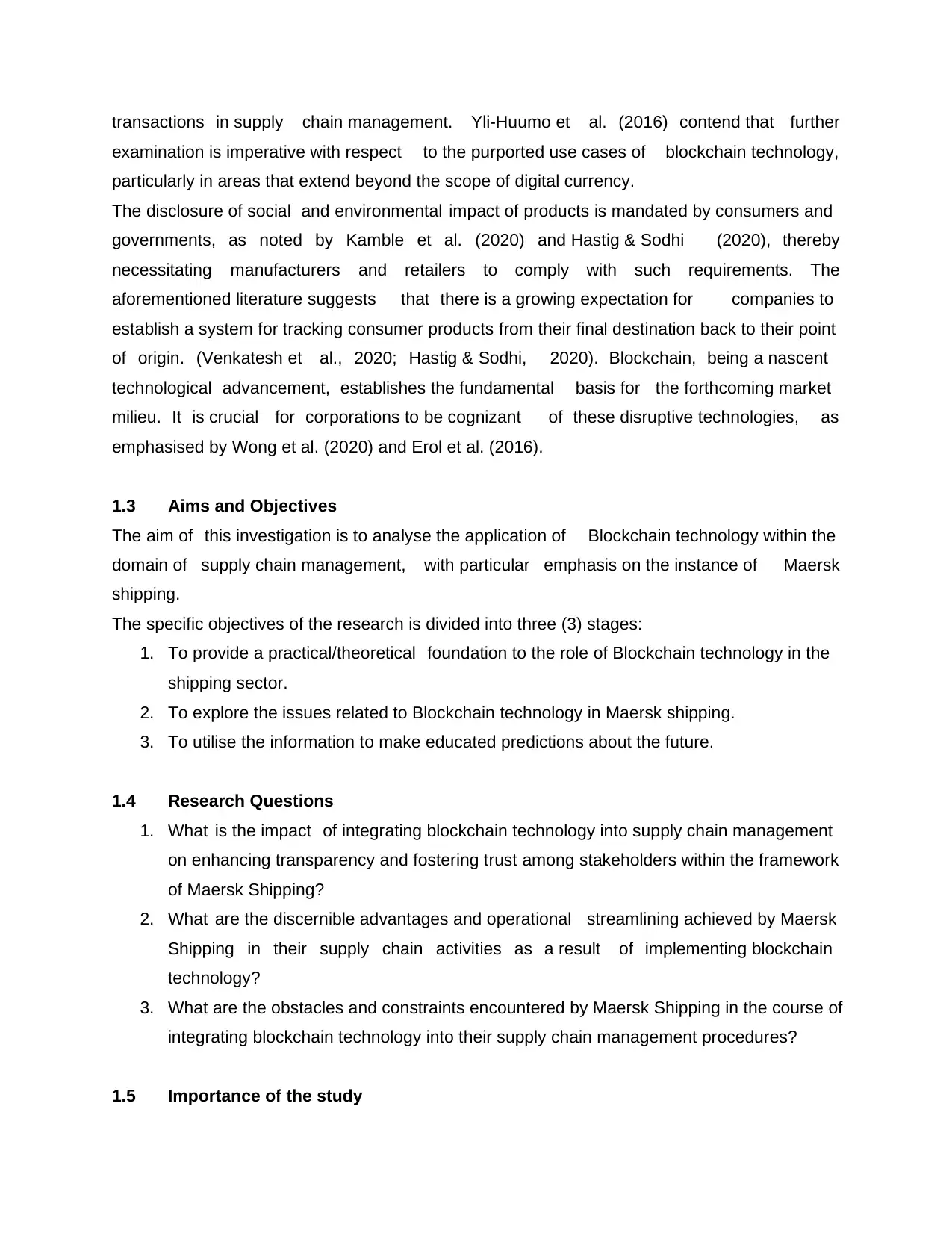
transactions in supply chain management. Yli-Huumo et al. (2016) contend that further
examination is imperative with respect to the purported use cases of blockchain technology,
particularly in areas that extend beyond the scope of digital currency.
The disclosure of social and environmental impact of products is mandated by consumers and
governments, as noted by Kamble et al. (2020) and Hastig & Sodhi (2020), thereby
necessitating manufacturers and retailers to comply with such requirements. The
aforementioned literature suggests that there is a growing expectation for companies to
establish a system for tracking consumer products from their final destination back to their point
of origin. (Venkatesh et al., 2020; Hastig & Sodhi, 2020). Blockchain, being a nascent
technological advancement, establishes the fundamental basis for the forthcoming market
milieu. It is crucial for corporations to be cognizant of these disruptive technologies, as
emphasised by Wong et al. (2020) and Erol et al. (2016).
1.3 Aims and Objectives
The aim of this investigation is to analyse the application of Blockchain technology within the
domain of supply chain management, with particular emphasis on the instance of Maersk
shipping.
The specific objectives of the research is divided into three (3) stages:
1. To provide a practical/theoretical foundation to the role of Blockchain technology in the
shipping sector.
2. To explore the issues related to Blockchain technology in Maersk shipping.
3. To utilise the information to make educated predictions about the future.
1.4 Research Questions
1. What is the impact of integrating blockchain technology into supply chain management
on enhancing transparency and fostering trust among stakeholders within the framework
of Maersk Shipping?
2. What are the discernible advantages and operational streamlining achieved by Maersk
Shipping in their supply chain activities as a result of implementing blockchain
technology?
3. What are the obstacles and constraints encountered by Maersk Shipping in the course of
integrating blockchain technology into their supply chain management procedures?
1.5 Importance of the study
examination is imperative with respect to the purported use cases of blockchain technology,
particularly in areas that extend beyond the scope of digital currency.
The disclosure of social and environmental impact of products is mandated by consumers and
governments, as noted by Kamble et al. (2020) and Hastig & Sodhi (2020), thereby
necessitating manufacturers and retailers to comply with such requirements. The
aforementioned literature suggests that there is a growing expectation for companies to
establish a system for tracking consumer products from their final destination back to their point
of origin. (Venkatesh et al., 2020; Hastig & Sodhi, 2020). Blockchain, being a nascent
technological advancement, establishes the fundamental basis for the forthcoming market
milieu. It is crucial for corporations to be cognizant of these disruptive technologies, as
emphasised by Wong et al. (2020) and Erol et al. (2016).
1.3 Aims and Objectives
The aim of this investigation is to analyse the application of Blockchain technology within the
domain of supply chain management, with particular emphasis on the instance of Maersk
shipping.
The specific objectives of the research is divided into three (3) stages:
1. To provide a practical/theoretical foundation to the role of Blockchain technology in the
shipping sector.
2. To explore the issues related to Blockchain technology in Maersk shipping.
3. To utilise the information to make educated predictions about the future.
1.4 Research Questions
1. What is the impact of integrating blockchain technology into supply chain management
on enhancing transparency and fostering trust among stakeholders within the framework
of Maersk Shipping?
2. What are the discernible advantages and operational streamlining achieved by Maersk
Shipping in their supply chain activities as a result of implementing blockchain
technology?
3. What are the obstacles and constraints encountered by Maersk Shipping in the course of
integrating blockchain technology into their supply chain management procedures?
1.5 Importance of the study
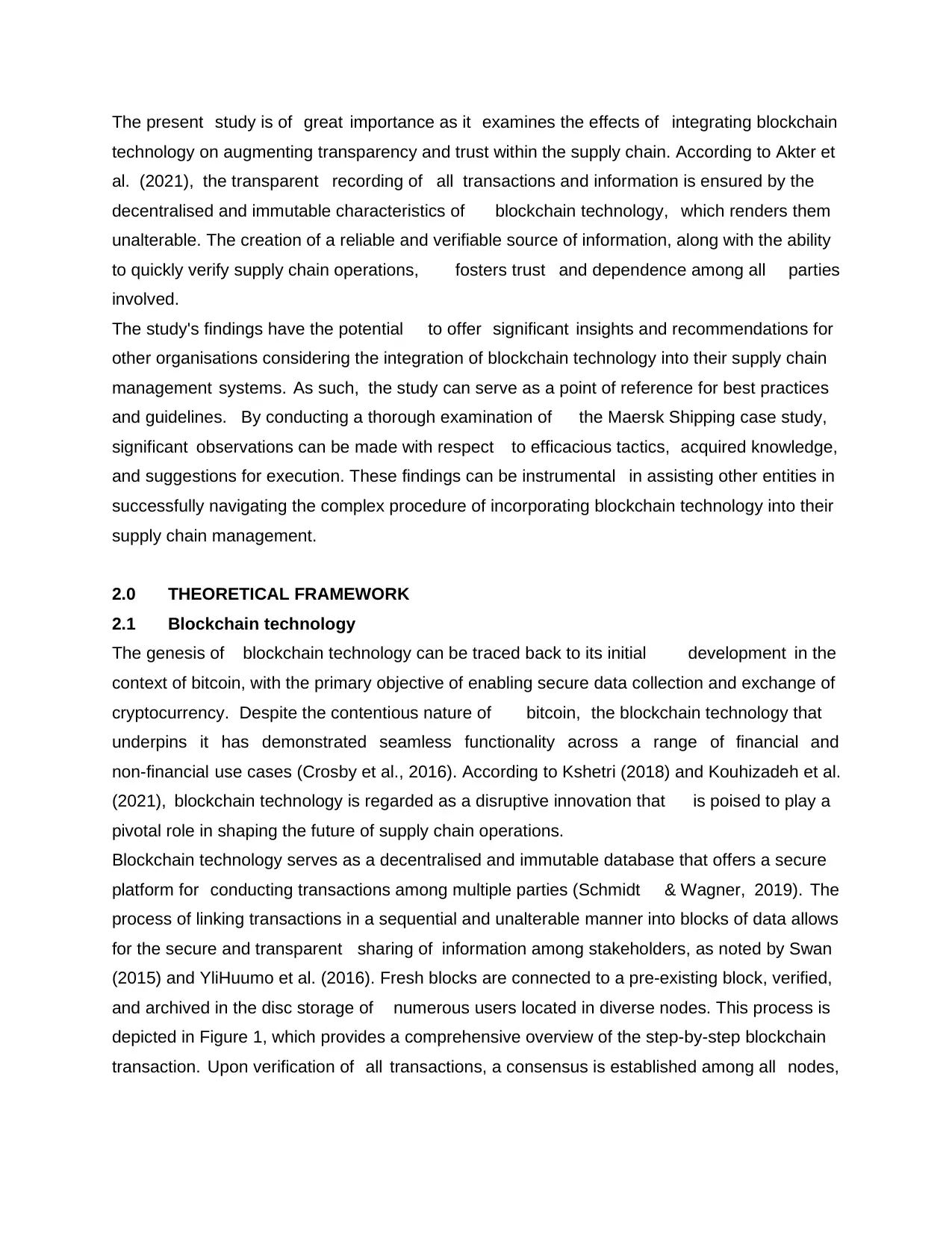
The present study is of great importance as it examines the effects of integrating blockchain
technology on augmenting transparency and trust within the supply chain. According to Akter et
al. (2021), the transparent recording of all transactions and information is ensured by the
decentralised and immutable characteristics of blockchain technology, which renders them
unalterable. The creation of a reliable and verifiable source of information, along with the ability
to quickly verify supply chain operations, fosters trust and dependence among all parties
involved.
The study's findings have the potential to offer significant insights and recommendations for
other organisations considering the integration of blockchain technology into their supply chain
management systems. As such, the study can serve as a point of reference for best practices
and guidelines. By conducting a thorough examination of the Maersk Shipping case study,
significant observations can be made with respect to efficacious tactics, acquired knowledge,
and suggestions for execution. These findings can be instrumental in assisting other entities in
successfully navigating the complex procedure of incorporating blockchain technology into their
supply chain management.
2.0 THEORETICAL FRAMEWORK
2.1 Blockchain technology
The genesis of blockchain technology can be traced back to its initial development in the
context of bitcoin, with the primary objective of enabling secure data collection and exchange of
cryptocurrency. Despite the contentious nature of bitcoin, the blockchain technology that
underpins it has demonstrated seamless functionality across a range of financial and
non-financial use cases (Crosby et al., 2016). According to Kshetri (2018) and Kouhizadeh et al.
(2021), blockchain technology is regarded as a disruptive innovation that is poised to play a
pivotal role in shaping the future of supply chain operations.
Blockchain technology serves as a decentralised and immutable database that offers a secure
platform for conducting transactions among multiple parties (Schmidt & Wagner, 2019). The
process of linking transactions in a sequential and unalterable manner into blocks of data allows
for the secure and transparent sharing of information among stakeholders, as noted by Swan
(2015) and YliHuumo et al. (2016). Fresh blocks are connected to a pre-existing block, verified,
and archived in the disc storage of numerous users located in diverse nodes. This process is
depicted in Figure 1, which provides a comprehensive overview of the step-by-step blockchain
transaction. Upon verification of all transactions, a consensus is established among all nodes,
technology on augmenting transparency and trust within the supply chain. According to Akter et
al. (2021), the transparent recording of all transactions and information is ensured by the
decentralised and immutable characteristics of blockchain technology, which renders them
unalterable. The creation of a reliable and verifiable source of information, along with the ability
to quickly verify supply chain operations, fosters trust and dependence among all parties
involved.
The study's findings have the potential to offer significant insights and recommendations for
other organisations considering the integration of blockchain technology into their supply chain
management systems. As such, the study can serve as a point of reference for best practices
and guidelines. By conducting a thorough examination of the Maersk Shipping case study,
significant observations can be made with respect to efficacious tactics, acquired knowledge,
and suggestions for execution. These findings can be instrumental in assisting other entities in
successfully navigating the complex procedure of incorporating blockchain technology into their
supply chain management.
2.0 THEORETICAL FRAMEWORK
2.1 Blockchain technology
The genesis of blockchain technology can be traced back to its initial development in the
context of bitcoin, with the primary objective of enabling secure data collection and exchange of
cryptocurrency. Despite the contentious nature of bitcoin, the blockchain technology that
underpins it has demonstrated seamless functionality across a range of financial and
non-financial use cases (Crosby et al., 2016). According to Kshetri (2018) and Kouhizadeh et al.
(2021), blockchain technology is regarded as a disruptive innovation that is poised to play a
pivotal role in shaping the future of supply chain operations.
Blockchain technology serves as a decentralised and immutable database that offers a secure
platform for conducting transactions among multiple parties (Schmidt & Wagner, 2019). The
process of linking transactions in a sequential and unalterable manner into blocks of data allows
for the secure and transparent sharing of information among stakeholders, as noted by Swan
(2015) and YliHuumo et al. (2016). Fresh blocks are connected to a pre-existing block, verified,
and archived in the disc storage of numerous users located in diverse nodes. This process is
depicted in Figure 1, which provides a comprehensive overview of the step-by-step blockchain
transaction. Upon verification of all transactions, a consensus is established among all nodes,
⊘ This is a preview!⊘
Do you want full access?
Subscribe today to unlock all pages.

Trusted by 1+ million students worldwide
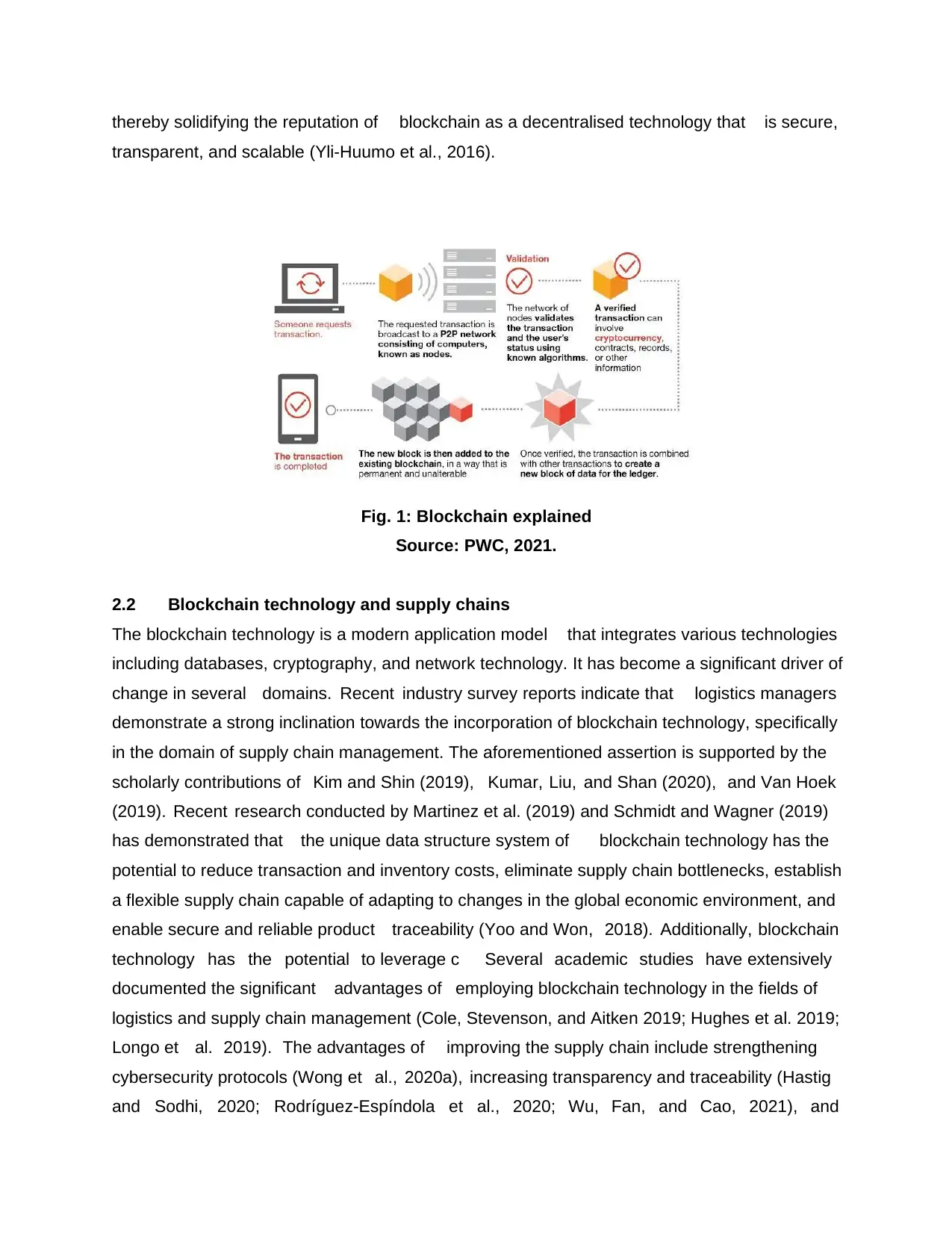
thereby solidifying the reputation of blockchain as a decentralised technology that is secure,
transparent, and scalable (Yli-Huumo et al., 2016).
Fig. 1: Blockchain explained
Source: PWC, 2021.
2.2 Blockchain technology and supply chains
The blockchain technology is a modern application model that integrates various technologies
including databases, cryptography, and network technology. It has become a significant driver of
change in several domains. Recent industry survey reports indicate that logistics managers
demonstrate a strong inclination towards the incorporation of blockchain technology, specifically
in the domain of supply chain management. The aforementioned assertion is supported by the
scholarly contributions of Kim and Shin (2019), Kumar, Liu, and Shan (2020), and Van Hoek
(2019). Recent research conducted by Martinez et al. (2019) and Schmidt and Wagner (2019)
has demonstrated that the unique data structure system of blockchain technology has the
potential to reduce transaction and inventory costs, eliminate supply chain bottlenecks, establish
a flexible supply chain capable of adapting to changes in the global economic environment, and
enable secure and reliable product traceability (Yoo and Won, 2018). Additionally, blockchain
technology has the potential to leverage c Several academic studies have extensively
documented the significant advantages of employing blockchain technology in the fields of
logistics and supply chain management (Cole, Stevenson, and Aitken 2019; Hughes et al. 2019;
Longo et al. 2019). The advantages of improving the supply chain include strengthening
cybersecurity protocols (Wong et al., 2020a), increasing transparency and traceability (Hastig
and Sodhi, 2020; Rodríguez-Espíndola et al., 2020; Wu, Fan, and Cao, 2021), and
transparent, and scalable (Yli-Huumo et al., 2016).
Fig. 1: Blockchain explained
Source: PWC, 2021.
2.2 Blockchain technology and supply chains
The blockchain technology is a modern application model that integrates various technologies
including databases, cryptography, and network technology. It has become a significant driver of
change in several domains. Recent industry survey reports indicate that logistics managers
demonstrate a strong inclination towards the incorporation of blockchain technology, specifically
in the domain of supply chain management. The aforementioned assertion is supported by the
scholarly contributions of Kim and Shin (2019), Kumar, Liu, and Shan (2020), and Van Hoek
(2019). Recent research conducted by Martinez et al. (2019) and Schmidt and Wagner (2019)
has demonstrated that the unique data structure system of blockchain technology has the
potential to reduce transaction and inventory costs, eliminate supply chain bottlenecks, establish
a flexible supply chain capable of adapting to changes in the global economic environment, and
enable secure and reliable product traceability (Yoo and Won, 2018). Additionally, blockchain
technology has the potential to leverage c Several academic studies have extensively
documented the significant advantages of employing blockchain technology in the fields of
logistics and supply chain management (Cole, Stevenson, and Aitken 2019; Hughes et al. 2019;
Longo et al. 2019). The advantages of improving the supply chain include strengthening
cybersecurity protocols (Wong et al., 2020a), increasing transparency and traceability (Hastig
and Sodhi, 2020; Rodríguez-Espíndola et al., 2020; Wu, Fan, and Cao, 2021), and
Paraphrase This Document
Need a fresh take? Get an instant paraphrase of this document with our AI Paraphraser
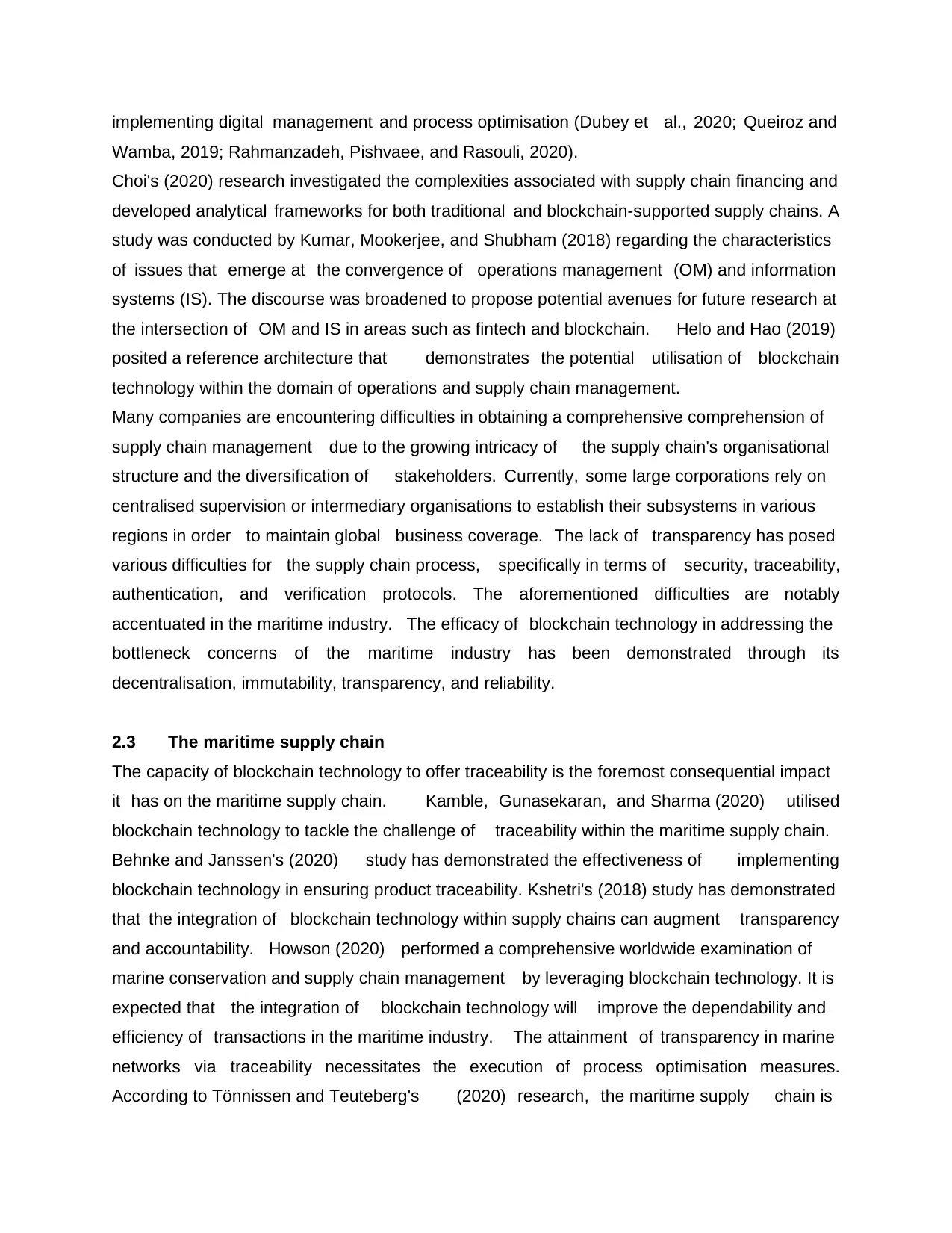
implementing digital management and process optimisation (Dubey et al., 2020; Queiroz and
Wamba, 2019; Rahmanzadeh, Pishvaee, and Rasouli, 2020).
Choi's (2020) research investigated the complexities associated with supply chain financing and
developed analytical frameworks for both traditional and blockchain-supported supply chains. A
study was conducted by Kumar, Mookerjee, and Shubham (2018) regarding the characteristics
of issues that emerge at the convergence of operations management (OM) and information
systems (IS). The discourse was broadened to propose potential avenues for future research at
the intersection of OM and IS in areas such as fintech and blockchain. Helo and Hao (2019)
posited a reference architecture that demonstrates the potential utilisation of blockchain
technology within the domain of operations and supply chain management.
Many companies are encountering difficulties in obtaining a comprehensive comprehension of
supply chain management due to the growing intricacy of the supply chain's organisational
structure and the diversification of stakeholders. Currently, some large corporations rely on
centralised supervision or intermediary organisations to establish their subsystems in various
regions in order to maintain global business coverage. The lack of transparency has posed
various difficulties for the supply chain process, specifically in terms of security, traceability,
authentication, and verification protocols. The aforementioned difficulties are notably
accentuated in the maritime industry. The efficacy of blockchain technology in addressing the
bottleneck concerns of the maritime industry has been demonstrated through its
decentralisation, immutability, transparency, and reliability.
2.3 The maritime supply chain
The capacity of blockchain technology to offer traceability is the foremost consequential impact
it has on the maritime supply chain. Kamble, Gunasekaran, and Sharma (2020) utilised
blockchain technology to tackle the challenge of traceability within the maritime supply chain.
Behnke and Janssen's (2020) study has demonstrated the effectiveness of implementing
blockchain technology in ensuring product traceability. Kshetri's (2018) study has demonstrated
that the integration of blockchain technology within supply chains can augment transparency
and accountability. Howson (2020) performed a comprehensive worldwide examination of
marine conservation and supply chain management by leveraging blockchain technology. It is
expected that the integration of blockchain technology will improve the dependability and
efficiency of transactions in the maritime industry. The attainment of transparency in marine
networks via traceability necessitates the execution of process optimisation measures.
According to Tönnissen and Teuteberg's (2020) research, the maritime supply chain is
Wamba, 2019; Rahmanzadeh, Pishvaee, and Rasouli, 2020).
Choi's (2020) research investigated the complexities associated with supply chain financing and
developed analytical frameworks for both traditional and blockchain-supported supply chains. A
study was conducted by Kumar, Mookerjee, and Shubham (2018) regarding the characteristics
of issues that emerge at the convergence of operations management (OM) and information
systems (IS). The discourse was broadened to propose potential avenues for future research at
the intersection of OM and IS in areas such as fintech and blockchain. Helo and Hao (2019)
posited a reference architecture that demonstrates the potential utilisation of blockchain
technology within the domain of operations and supply chain management.
Many companies are encountering difficulties in obtaining a comprehensive comprehension of
supply chain management due to the growing intricacy of the supply chain's organisational
structure and the diversification of stakeholders. Currently, some large corporations rely on
centralised supervision or intermediary organisations to establish their subsystems in various
regions in order to maintain global business coverage. The lack of transparency has posed
various difficulties for the supply chain process, specifically in terms of security, traceability,
authentication, and verification protocols. The aforementioned difficulties are notably
accentuated in the maritime industry. The efficacy of blockchain technology in addressing the
bottleneck concerns of the maritime industry has been demonstrated through its
decentralisation, immutability, transparency, and reliability.
2.3 The maritime supply chain
The capacity of blockchain technology to offer traceability is the foremost consequential impact
it has on the maritime supply chain. Kamble, Gunasekaran, and Sharma (2020) utilised
blockchain technology to tackle the challenge of traceability within the maritime supply chain.
Behnke and Janssen's (2020) study has demonstrated the effectiveness of implementing
blockchain technology in ensuring product traceability. Kshetri's (2018) study has demonstrated
that the integration of blockchain technology within supply chains can augment transparency
and accountability. Howson (2020) performed a comprehensive worldwide examination of
marine conservation and supply chain management by leveraging blockchain technology. It is
expected that the integration of blockchain technology will improve the dependability and
efficiency of transactions in the maritime industry. The attainment of transparency in marine
networks via traceability necessitates the execution of process optimisation measures.
According to Tönnissen and Teuteberg's (2020) research, the maritime supply chain is
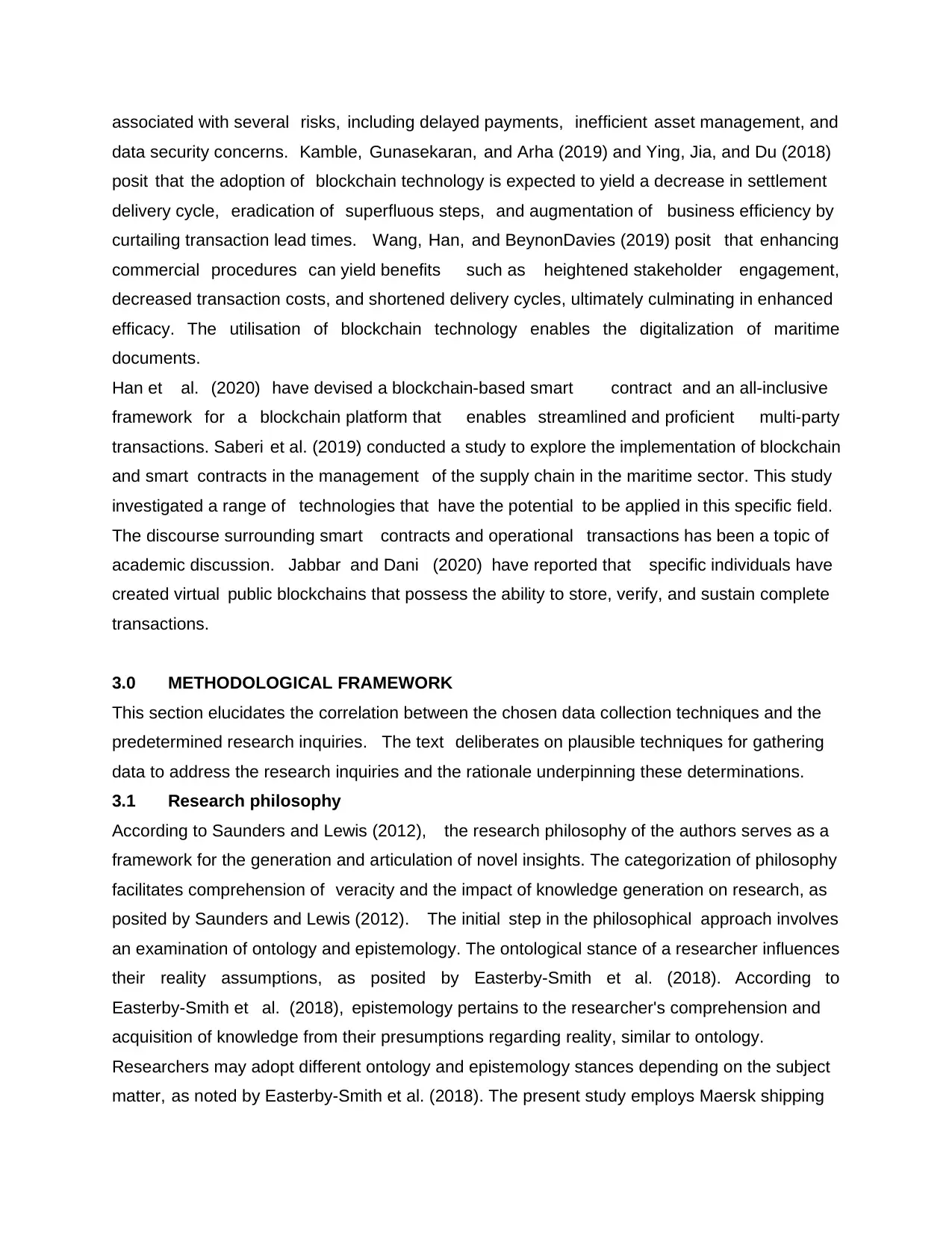
associated with several risks, including delayed payments, inefficient asset management, and
data security concerns. Kamble, Gunasekaran, and Arha (2019) and Ying, Jia, and Du (2018)
posit that the adoption of blockchain technology is expected to yield a decrease in settlement
delivery cycle, eradication of superfluous steps, and augmentation of business efficiency by
curtailing transaction lead times. Wang, Han, and BeynonDavies (2019) posit that enhancing
commercial procedures can yield benefits such as heightened stakeholder engagement,
decreased transaction costs, and shortened delivery cycles, ultimately culminating in enhanced
efficacy. The utilisation of blockchain technology enables the digitalization of maritime
documents.
Han et al. (2020) have devised a blockchain-based smart contract and an all-inclusive
framework for a blockchain platform that enables streamlined and proficient multi-party
transactions. Saberi et al. (2019) conducted a study to explore the implementation of blockchain
and smart contracts in the management of the supply chain in the maritime sector. This study
investigated a range of technologies that have the potential to be applied in this specific field.
The discourse surrounding smart contracts and operational transactions has been a topic of
academic discussion. Jabbar and Dani (2020) have reported that specific individuals have
created virtual public blockchains that possess the ability to store, verify, and sustain complete
transactions.
3.0 METHODOLOGICAL FRAMEWORK
This section elucidates the correlation between the chosen data collection techniques and the
predetermined research inquiries. The text deliberates on plausible techniques for gathering
data to address the research inquiries and the rationale underpinning these determinations.
3.1 Research philosophy
According to Saunders and Lewis (2012), the research philosophy of the authors serves as a
framework for the generation and articulation of novel insights. The categorization of philosophy
facilitates comprehension of veracity and the impact of knowledge generation on research, as
posited by Saunders and Lewis (2012). The initial step in the philosophical approach involves
an examination of ontology and epistemology. The ontological stance of a researcher influences
their reality assumptions, as posited by Easterby-Smith et al. (2018). According to
Easterby-Smith et al. (2018), epistemology pertains to the researcher's comprehension and
acquisition of knowledge from their presumptions regarding reality, similar to ontology.
Researchers may adopt different ontology and epistemology stances depending on the subject
matter, as noted by Easterby-Smith et al. (2018). The present study employs Maersk shipping
data security concerns. Kamble, Gunasekaran, and Arha (2019) and Ying, Jia, and Du (2018)
posit that the adoption of blockchain technology is expected to yield a decrease in settlement
delivery cycle, eradication of superfluous steps, and augmentation of business efficiency by
curtailing transaction lead times. Wang, Han, and BeynonDavies (2019) posit that enhancing
commercial procedures can yield benefits such as heightened stakeholder engagement,
decreased transaction costs, and shortened delivery cycles, ultimately culminating in enhanced
efficacy. The utilisation of blockchain technology enables the digitalization of maritime
documents.
Han et al. (2020) have devised a blockchain-based smart contract and an all-inclusive
framework for a blockchain platform that enables streamlined and proficient multi-party
transactions. Saberi et al. (2019) conducted a study to explore the implementation of blockchain
and smart contracts in the management of the supply chain in the maritime sector. This study
investigated a range of technologies that have the potential to be applied in this specific field.
The discourse surrounding smart contracts and operational transactions has been a topic of
academic discussion. Jabbar and Dani (2020) have reported that specific individuals have
created virtual public blockchains that possess the ability to store, verify, and sustain complete
transactions.
3.0 METHODOLOGICAL FRAMEWORK
This section elucidates the correlation between the chosen data collection techniques and the
predetermined research inquiries. The text deliberates on plausible techniques for gathering
data to address the research inquiries and the rationale underpinning these determinations.
3.1 Research philosophy
According to Saunders and Lewis (2012), the research philosophy of the authors serves as a
framework for the generation and articulation of novel insights. The categorization of philosophy
facilitates comprehension of veracity and the impact of knowledge generation on research, as
posited by Saunders and Lewis (2012). The initial step in the philosophical approach involves
an examination of ontology and epistemology. The ontological stance of a researcher influences
their reality assumptions, as posited by Easterby-Smith et al. (2018). According to
Easterby-Smith et al. (2018), epistemology pertains to the researcher's comprehension and
acquisition of knowledge from their presumptions regarding reality, similar to ontology.
Researchers may adopt different ontology and epistemology stances depending on the subject
matter, as noted by Easterby-Smith et al. (2018). The present study employs Maersk shipping
⊘ This is a preview!⊘
Do you want full access?
Subscribe today to unlock all pages.

Trusted by 1+ million students worldwide
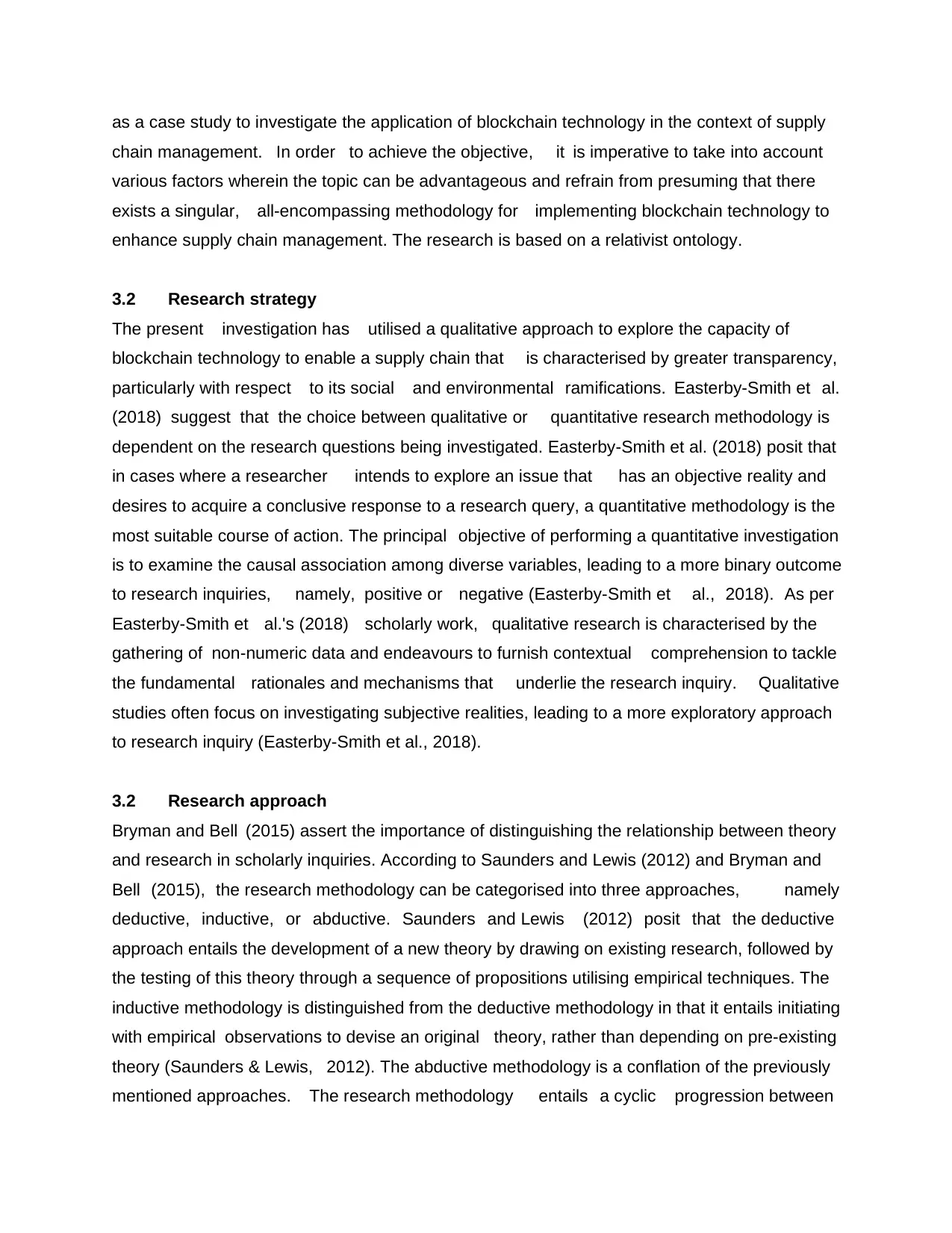
as a case study to investigate the application of blockchain technology in the context of supply
chain management. In order to achieve the objective, it is imperative to take into account
various factors wherein the topic can be advantageous and refrain from presuming that there
exists a singular, all-encompassing methodology for implementing blockchain technology to
enhance supply chain management. The research is based on a relativist ontology.
3.2 Research strategy
The present investigation has utilised a qualitative approach to explore the capacity of
blockchain technology to enable a supply chain that is characterised by greater transparency,
particularly with respect to its social and environmental ramifications. Easterby-Smith et al.
(2018) suggest that the choice between qualitative or quantitative research methodology is
dependent on the research questions being investigated. Easterby-Smith et al. (2018) posit that
in cases where a researcher intends to explore an issue that has an objective reality and
desires to acquire a conclusive response to a research query, a quantitative methodology is the
most suitable course of action. The principal objective of performing a quantitative investigation
is to examine the causal association among diverse variables, leading to a more binary outcome
to research inquiries, namely, positive or negative (Easterby-Smith et al., 2018). As per
Easterby-Smith et al.'s (2018) scholarly work, qualitative research is characterised by the
gathering of non-numeric data and endeavours to furnish contextual comprehension to tackle
the fundamental rationales and mechanisms that underlie the research inquiry. Qualitative
studies often focus on investigating subjective realities, leading to a more exploratory approach
to research inquiry (Easterby-Smith et al., 2018).
3.2 Research approach
Bryman and Bell (2015) assert the importance of distinguishing the relationship between theory
and research in scholarly inquiries. According to Saunders and Lewis (2012) and Bryman and
Bell (2015), the research methodology can be categorised into three approaches, namely
deductive, inductive, or abductive. Saunders and Lewis (2012) posit that the deductive
approach entails the development of a new theory by drawing on existing research, followed by
the testing of this theory through a sequence of propositions utilising empirical techniques. The
inductive methodology is distinguished from the deductive methodology in that it entails initiating
with empirical observations to devise an original theory, rather than depending on pre-existing
theory (Saunders & Lewis, 2012). The abductive methodology is a conflation of the previously
mentioned approaches. The research methodology entails a cyclic progression between
chain management. In order to achieve the objective, it is imperative to take into account
various factors wherein the topic can be advantageous and refrain from presuming that there
exists a singular, all-encompassing methodology for implementing blockchain technology to
enhance supply chain management. The research is based on a relativist ontology.
3.2 Research strategy
The present investigation has utilised a qualitative approach to explore the capacity of
blockchain technology to enable a supply chain that is characterised by greater transparency,
particularly with respect to its social and environmental ramifications. Easterby-Smith et al.
(2018) suggest that the choice between qualitative or quantitative research methodology is
dependent on the research questions being investigated. Easterby-Smith et al. (2018) posit that
in cases where a researcher intends to explore an issue that has an objective reality and
desires to acquire a conclusive response to a research query, a quantitative methodology is the
most suitable course of action. The principal objective of performing a quantitative investigation
is to examine the causal association among diverse variables, leading to a more binary outcome
to research inquiries, namely, positive or negative (Easterby-Smith et al., 2018). As per
Easterby-Smith et al.'s (2018) scholarly work, qualitative research is characterised by the
gathering of non-numeric data and endeavours to furnish contextual comprehension to tackle
the fundamental rationales and mechanisms that underlie the research inquiry. Qualitative
studies often focus on investigating subjective realities, leading to a more exploratory approach
to research inquiry (Easterby-Smith et al., 2018).
3.2 Research approach
Bryman and Bell (2015) assert the importance of distinguishing the relationship between theory
and research in scholarly inquiries. According to Saunders and Lewis (2012) and Bryman and
Bell (2015), the research methodology can be categorised into three approaches, namely
deductive, inductive, or abductive. Saunders and Lewis (2012) posit that the deductive
approach entails the development of a new theory by drawing on existing research, followed by
the testing of this theory through a sequence of propositions utilising empirical techniques. The
inductive methodology is distinguished from the deductive methodology in that it entails initiating
with empirical observations to devise an original theory, rather than depending on pre-existing
theory (Saunders & Lewis, 2012). The abductive methodology is a conflation of the previously
mentioned approaches. The research methodology entails a cyclic progression between
Paraphrase This Document
Need a fresh take? Get an instant paraphrase of this document with our AI Paraphraser
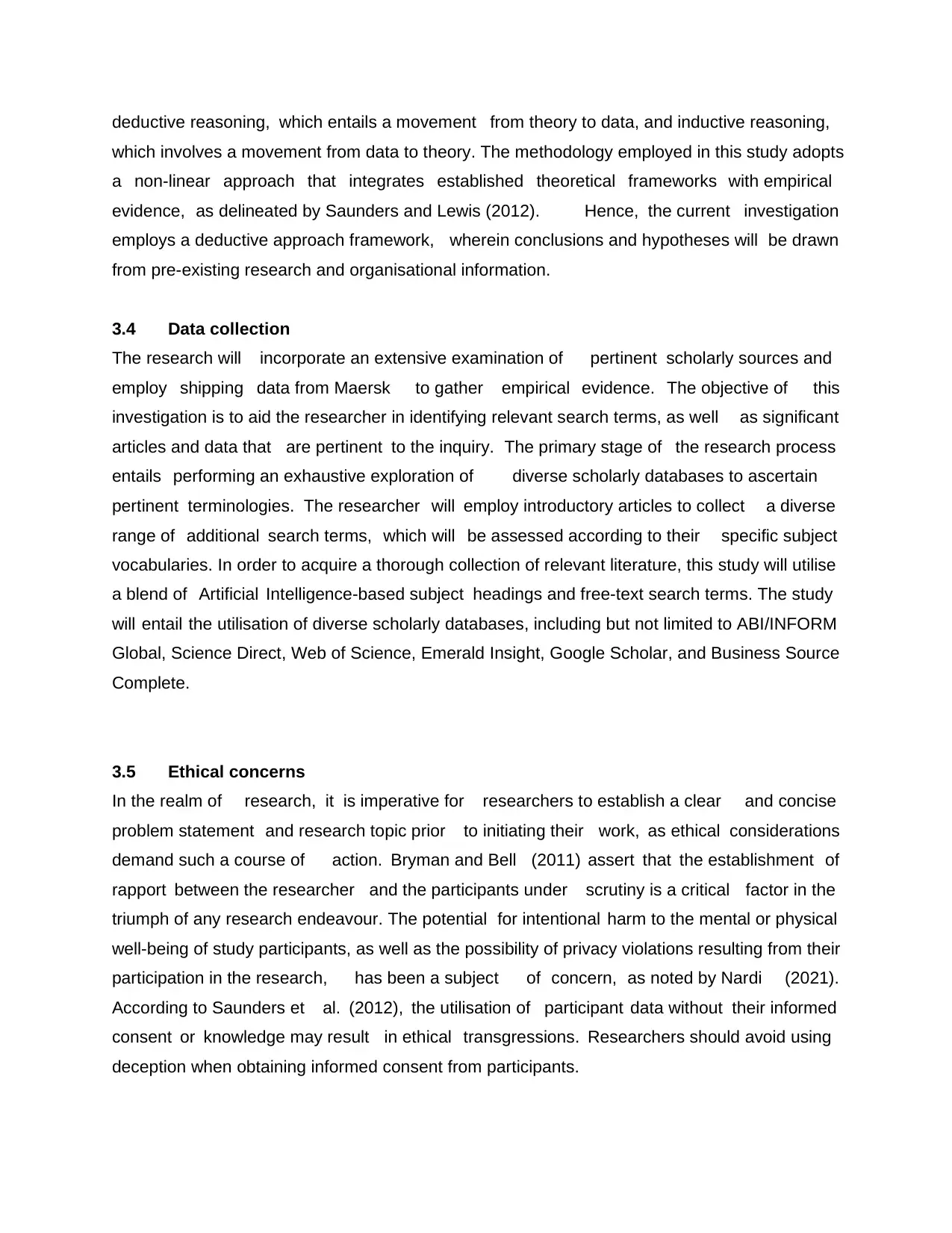
deductive reasoning, which entails a movement from theory to data, and inductive reasoning,
which involves a movement from data to theory. The methodology employed in this study adopts
a non-linear approach that integrates established theoretical frameworks with empirical
evidence, as delineated by Saunders and Lewis (2012). Hence, the current investigation
employs a deductive approach framework, wherein conclusions and hypotheses will be drawn
from pre-existing research and organisational information.
3.4 Data collection
The research will incorporate an extensive examination of pertinent scholarly sources and
employ shipping data from Maersk to gather empirical evidence. The objective of this
investigation is to aid the researcher in identifying relevant search terms, as well as significant
articles and data that are pertinent to the inquiry. The primary stage of the research process
entails performing an exhaustive exploration of diverse scholarly databases to ascertain
pertinent terminologies. The researcher will employ introductory articles to collect a diverse
range of additional search terms, which will be assessed according to their specific subject
vocabularies. In order to acquire a thorough collection of relevant literature, this study will utilise
a blend of Artificial Intelligence-based subject headings and free-text search terms. The study
will entail the utilisation of diverse scholarly databases, including but not limited to ABI/INFORM
Global, Science Direct, Web of Science, Emerald Insight, Google Scholar, and Business Source
Complete.
3.5 Ethical concerns
In the realm of research, it is imperative for researchers to establish a clear and concise
problem statement and research topic prior to initiating their work, as ethical considerations
demand such a course of action. Bryman and Bell (2011) assert that the establishment of
rapport between the researcher and the participants under scrutiny is a critical factor in the
triumph of any research endeavour. The potential for intentional harm to the mental or physical
well-being of study participants, as well as the possibility of privacy violations resulting from their
participation in the research, has been a subject of concern, as noted by Nardi (2021).
According to Saunders et al. (2012), the utilisation of participant data without their informed
consent or knowledge may result in ethical transgressions. Researchers should avoid using
deception when obtaining informed consent from participants.
which involves a movement from data to theory. The methodology employed in this study adopts
a non-linear approach that integrates established theoretical frameworks with empirical
evidence, as delineated by Saunders and Lewis (2012). Hence, the current investigation
employs a deductive approach framework, wherein conclusions and hypotheses will be drawn
from pre-existing research and organisational information.
3.4 Data collection
The research will incorporate an extensive examination of pertinent scholarly sources and
employ shipping data from Maersk to gather empirical evidence. The objective of this
investigation is to aid the researcher in identifying relevant search terms, as well as significant
articles and data that are pertinent to the inquiry. The primary stage of the research process
entails performing an exhaustive exploration of diverse scholarly databases to ascertain
pertinent terminologies. The researcher will employ introductory articles to collect a diverse
range of additional search terms, which will be assessed according to their specific subject
vocabularies. In order to acquire a thorough collection of relevant literature, this study will utilise
a blend of Artificial Intelligence-based subject headings and free-text search terms. The study
will entail the utilisation of diverse scholarly databases, including but not limited to ABI/INFORM
Global, Science Direct, Web of Science, Emerald Insight, Google Scholar, and Business Source
Complete.
3.5 Ethical concerns
In the realm of research, it is imperative for researchers to establish a clear and concise
problem statement and research topic prior to initiating their work, as ethical considerations
demand such a course of action. Bryman and Bell (2011) assert that the establishment of
rapport between the researcher and the participants under scrutiny is a critical factor in the
triumph of any research endeavour. The potential for intentional harm to the mental or physical
well-being of study participants, as well as the possibility of privacy violations resulting from their
participation in the research, has been a subject of concern, as noted by Nardi (2021).
According to Saunders et al. (2012), the utilisation of participant data without their informed
consent or knowledge may result in ethical transgressions. Researchers should avoid using
deception when obtaining informed consent from participants.
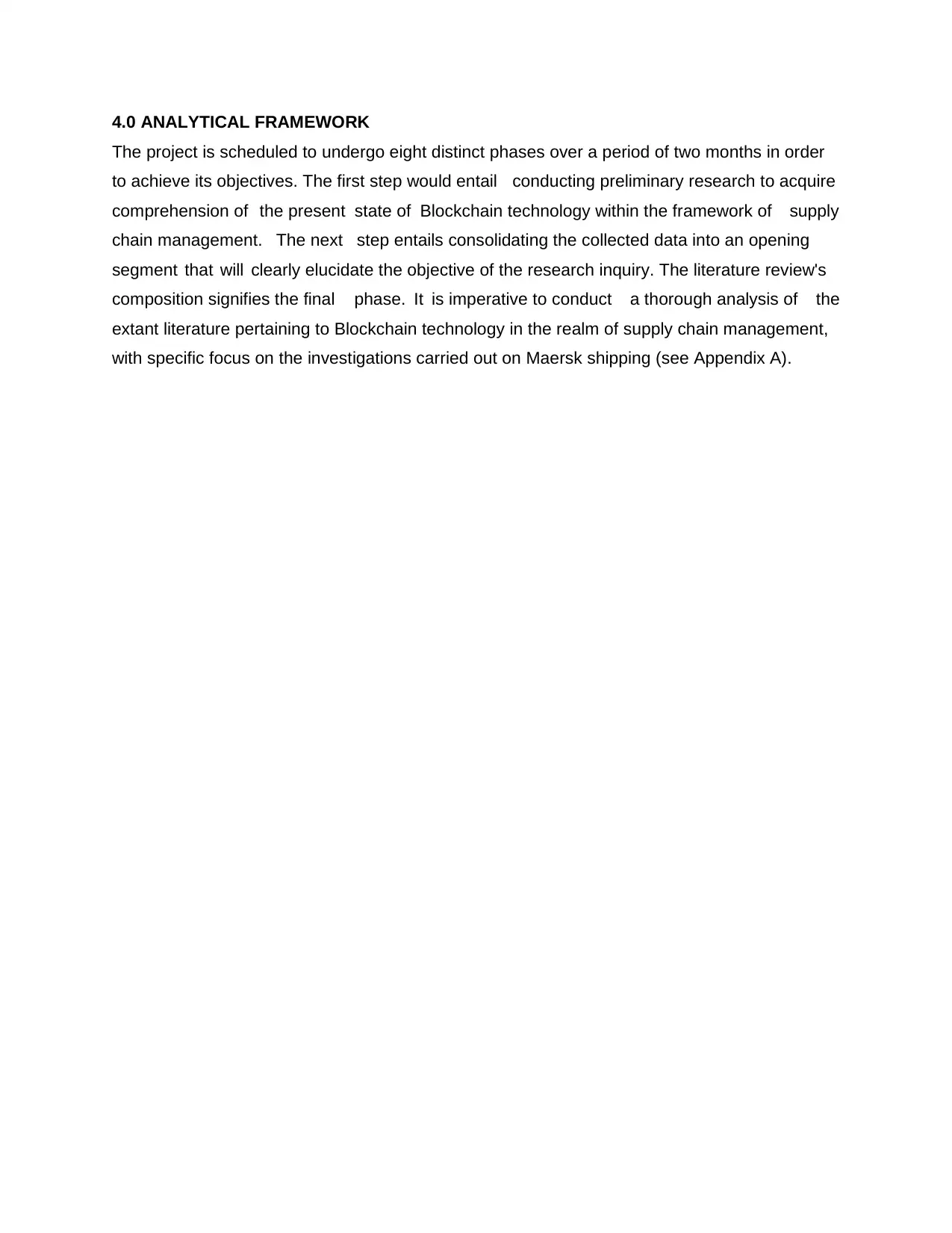
4.0 ANALYTICAL FRAMEWORK
The project is scheduled to undergo eight distinct phases over a period of two months in order
to achieve its objectives. The first step would entail conducting preliminary research to acquire
comprehension of the present state of Blockchain technology within the framework of supply
chain management. The next step entails consolidating the collected data into an opening
segment that will clearly elucidate the objective of the research inquiry. The literature review's
composition signifies the final phase. It is imperative to conduct a thorough analysis of the
extant literature pertaining to Blockchain technology in the realm of supply chain management,
with specific focus on the investigations carried out on Maersk shipping (see Appendix A).
The project is scheduled to undergo eight distinct phases over a period of two months in order
to achieve its objectives. The first step would entail conducting preliminary research to acquire
comprehension of the present state of Blockchain technology within the framework of supply
chain management. The next step entails consolidating the collected data into an opening
segment that will clearly elucidate the objective of the research inquiry. The literature review's
composition signifies the final phase. It is imperative to conduct a thorough analysis of the
extant literature pertaining to Blockchain technology in the realm of supply chain management,
with specific focus on the investigations carried out on Maersk shipping (see Appendix A).
⊘ This is a preview!⊘
Do you want full access?
Subscribe today to unlock all pages.

Trusted by 1+ million students worldwide
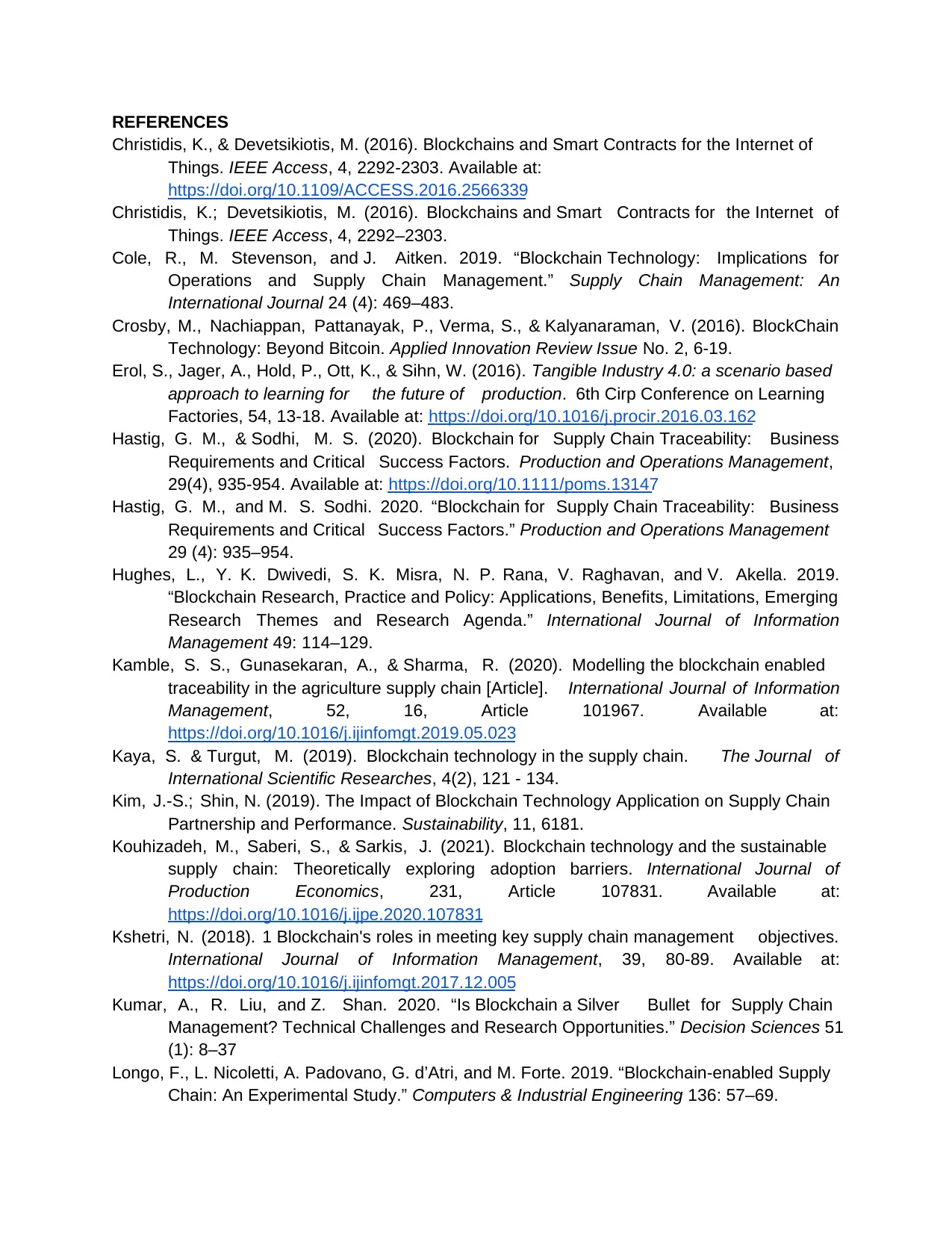
REFERENCES
Christidis, K., & Devetsikiotis, M. (2016). Blockchains and Smart Contracts for the Internet of
Things. IEEE Access, 4, 2292-2303. Available at:
https://doi.org/10.1109/ACCESS.2016.2566339
Christidis, K.; Devetsikiotis, M. (2016). Blockchains and Smart Contracts for the Internet of
Things. IEEE Access, 4, 2292–2303.
Cole, R., M. Stevenson, and J. Aitken. 2019. “Blockchain Technology: Implications for
Operations and Supply Chain Management.” Supply Chain Management: An
International Journal 24 (4): 469–483.
Crosby, M., Nachiappan, Pattanayak, P., Verma, S., & Kalyanaraman, V. (2016). BlockChain
Technology: Beyond Bitcoin. Applied Innovation Review Issue No. 2, 6-19.
Erol, S., Jager, A., Hold, P., Ott, K., & Sihn, W. (2016). Tangible Industry 4.0: a scenario based
approach to learning for the future of production. 6th Cirp Conference on Learning
Factories, 54, 13-18. Available at: https://doi.org/10.1016/j.procir.2016.03.162
Hastig, G. M., & Sodhi, M. S. (2020). Blockchain for Supply Chain Traceability: Business
Requirements and Critical Success Factors. Production and Operations Management,
29(4), 935-954. Available at: https://doi.org/10.1111/poms.13147
Hastig, G. M., and M. S. Sodhi. 2020. “Blockchain for Supply Chain Traceability: Business
Requirements and Critical Success Factors.” Production and Operations Management
29 (4): 935–954.
Hughes, L., Y. K. Dwivedi, S. K. Misra, N. P. Rana, V. Raghavan, and V. Akella. 2019.
“Blockchain Research, Practice and Policy: Applications, Benefits, Limitations, Emerging
Research Themes and Research Agenda.” International Journal of Information
Management 49: 114–129.
Kamble, S. S., Gunasekaran, A., & Sharma, R. (2020). Modelling the blockchain enabled
traceability in the agriculture supply chain [Article]. International Journal of Information
Management, 52, 16, Article 101967. Available at:
https://doi.org/10.1016/j.ijinfomgt.2019.05.023
Kaya, S. & Turgut, M. (2019). Blockchain technology in the supply chain. The Journal of
International Scientific Researches, 4(2), 121 - 134.
Kim, J.-S.; Shin, N. (2019). The Impact of Blockchain Technology Application on Supply Chain
Partnership and Performance. Sustainability, 11, 6181.
Kouhizadeh, M., Saberi, S., & Sarkis, J. (2021). Blockchain technology and the sustainable
supply chain: Theoretically exploring adoption barriers. International Journal of
Production Economics, 231, Article 107831. Available at:
https://doi.org/10.1016/j.ijpe.2020.107831
Kshetri, N. (2018). 1 Blockchain's roles in meeting key supply chain management objectives.
International Journal of Information Management, 39, 80-89. Available at:
https://doi.org/10.1016/j.ijinfomgt.2017.12.005
Kumar, A., R. Liu, and Z. Shan. 2020. “Is Blockchain a Silver Bullet for Supply Chain
Management? Technical Challenges and Research Opportunities.” Decision Sciences 51
(1): 8–37
Longo, F., L. Nicoletti, A. Padovano, G. d’Atri, and M. Forte. 2019. “Blockchain-enabled Supply
Chain: An Experimental Study.” Computers & Industrial Engineering 136: 57–69.
Christidis, K., & Devetsikiotis, M. (2016). Blockchains and Smart Contracts for the Internet of
Things. IEEE Access, 4, 2292-2303. Available at:
https://doi.org/10.1109/ACCESS.2016.2566339
Christidis, K.; Devetsikiotis, M. (2016). Blockchains and Smart Contracts for the Internet of
Things. IEEE Access, 4, 2292–2303.
Cole, R., M. Stevenson, and J. Aitken. 2019. “Blockchain Technology: Implications for
Operations and Supply Chain Management.” Supply Chain Management: An
International Journal 24 (4): 469–483.
Crosby, M., Nachiappan, Pattanayak, P., Verma, S., & Kalyanaraman, V. (2016). BlockChain
Technology: Beyond Bitcoin. Applied Innovation Review Issue No. 2, 6-19.
Erol, S., Jager, A., Hold, P., Ott, K., & Sihn, W. (2016). Tangible Industry 4.0: a scenario based
approach to learning for the future of production. 6th Cirp Conference on Learning
Factories, 54, 13-18. Available at: https://doi.org/10.1016/j.procir.2016.03.162
Hastig, G. M., & Sodhi, M. S. (2020). Blockchain for Supply Chain Traceability: Business
Requirements and Critical Success Factors. Production and Operations Management,
29(4), 935-954. Available at: https://doi.org/10.1111/poms.13147
Hastig, G. M., and M. S. Sodhi. 2020. “Blockchain for Supply Chain Traceability: Business
Requirements and Critical Success Factors.” Production and Operations Management
29 (4): 935–954.
Hughes, L., Y. K. Dwivedi, S. K. Misra, N. P. Rana, V. Raghavan, and V. Akella. 2019.
“Blockchain Research, Practice and Policy: Applications, Benefits, Limitations, Emerging
Research Themes and Research Agenda.” International Journal of Information
Management 49: 114–129.
Kamble, S. S., Gunasekaran, A., & Sharma, R. (2020). Modelling the blockchain enabled
traceability in the agriculture supply chain [Article]. International Journal of Information
Management, 52, 16, Article 101967. Available at:
https://doi.org/10.1016/j.ijinfomgt.2019.05.023
Kaya, S. & Turgut, M. (2019). Blockchain technology in the supply chain. The Journal of
International Scientific Researches, 4(2), 121 - 134.
Kim, J.-S.; Shin, N. (2019). The Impact of Blockchain Technology Application on Supply Chain
Partnership and Performance. Sustainability, 11, 6181.
Kouhizadeh, M., Saberi, S., & Sarkis, J. (2021). Blockchain technology and the sustainable
supply chain: Theoretically exploring adoption barriers. International Journal of
Production Economics, 231, Article 107831. Available at:
https://doi.org/10.1016/j.ijpe.2020.107831
Kshetri, N. (2018). 1 Blockchain's roles in meeting key supply chain management objectives.
International Journal of Information Management, 39, 80-89. Available at:
https://doi.org/10.1016/j.ijinfomgt.2017.12.005
Kumar, A., R. Liu, and Z. Shan. 2020. “Is Blockchain a Silver Bullet for Supply Chain
Management? Technical Challenges and Research Opportunities.” Decision Sciences 51
(1): 8–37
Longo, F., L. Nicoletti, A. Padovano, G. d’Atri, and M. Forte. 2019. “Blockchain-enabled Supply
Chain: An Experimental Study.” Computers & Industrial Engineering 136: 57–69.
Paraphrase This Document
Need a fresh take? Get an instant paraphrase of this document with our AI Paraphraser
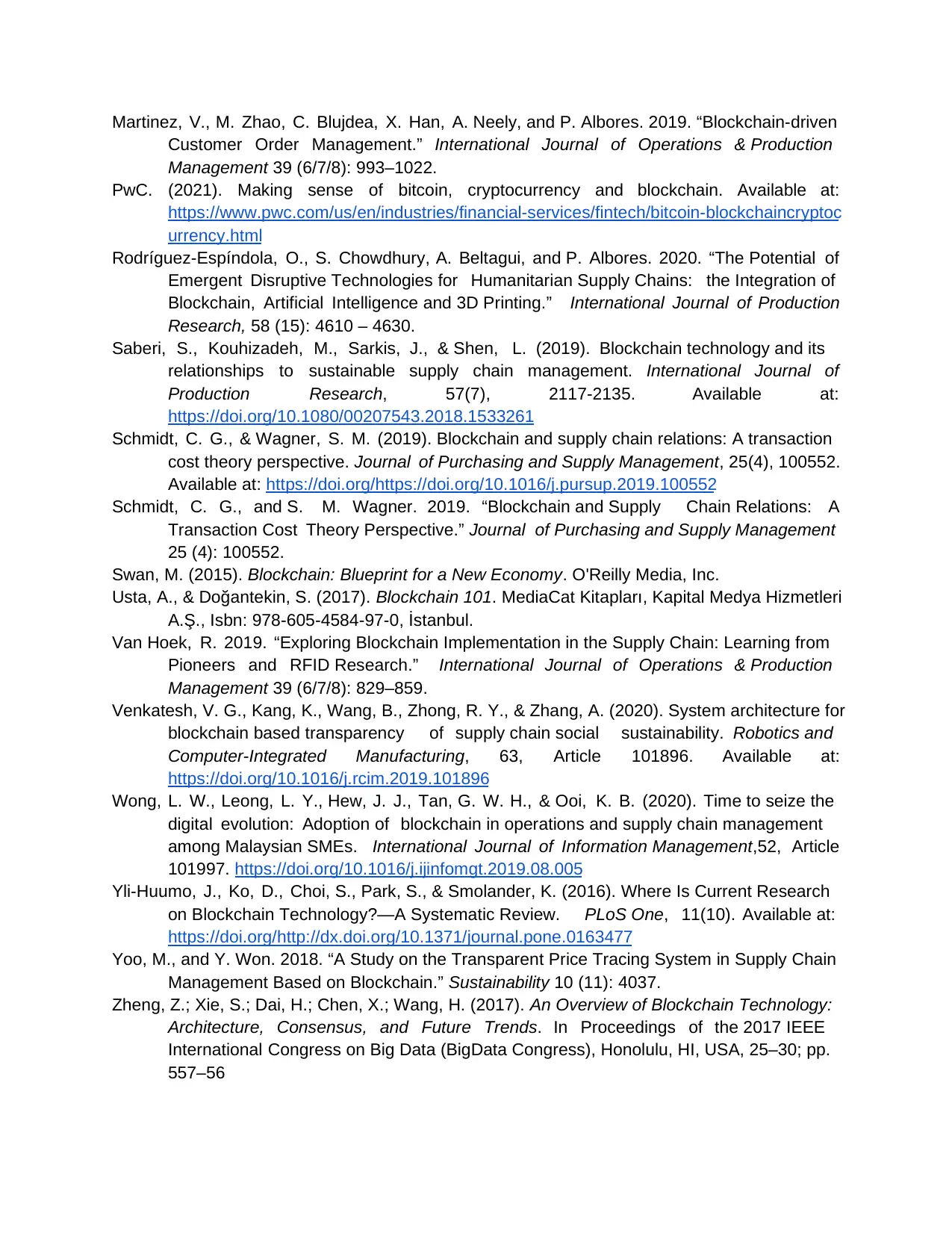
Martinez, V., M. Zhao, C. Blujdea, X. Han, A. Neely, and P. Albores. 2019. “Blockchain-driven
Customer Order Management.” International Journal of Operations & Production
Management 39 (6/7/8): 993–1022.
PwC. (2021). Making sense of bitcoin, cryptocurrency and blockchain. Available at:
https://www.pwc.com/us/en/industries/financial-services/fintech/bitcoin-blockchaincryptoc
urrency.html
Rodríguez-Espíndola, O., S. Chowdhury, A. Beltagui, and P. Albores. 2020. “The Potential of
Emergent Disruptive Technologies for Humanitarian Supply Chains: the Integration of
Blockchain, Artificial Intelligence and 3D Printing.” International Journal of Production
Research, 58 (15): 4610 – 4630.
Saberi, S., Kouhizadeh, M., Sarkis, J., & Shen, L. (2019). Blockchain technology and its
relationships to sustainable supply chain management. International Journal of
Production Research, 57(7), 2117-2135. Available at:
https://doi.org/10.1080/00207543.2018.1533261
Schmidt, C. G., & Wagner, S. M. (2019). Blockchain and supply chain relations: A transaction
cost theory perspective. Journal of Purchasing and Supply Management, 25(4), 100552.
Available at: https://doi.org/https://doi.org/10.1016/j.pursup.2019.100552
Schmidt, C. G., and S. M. Wagner. 2019. “Blockchain and Supply Chain Relations: A
Transaction Cost Theory Perspective.” Journal of Purchasing and Supply Management
25 (4): 100552.
Swan, M. (2015). Blockchain: Blueprint for a New Economy. O'Reilly Media, Inc.
Usta, A., & Doğantekin, S. (2017). Blockchain 101. MediaCat Kitapları, Kapital Medya Hizmetleri
A.Ş., Isbn: 978-605-4584-97-0, İstanbul.
Van Hoek, R. 2019. “Exploring Blockchain Implementation in the Supply Chain: Learning from
Pioneers and RFID Research.” International Journal of Operations & Production
Management 39 (6/7/8): 829–859.
Venkatesh, V. G., Kang, K., Wang, B., Zhong, R. Y., & Zhang, A. (2020). System architecture for
blockchain based transparency of supply chain social sustainability. Robotics and
Computer-Integrated Manufacturing, 63, Article 101896. Available at:
https://doi.org/10.1016/j.rcim.2019.101896
Wong, L. W., Leong, L. Y., Hew, J. J., Tan, G. W. H., & Ooi, K. B. (2020). Time to seize the
digital evolution: Adoption of blockchain in operations and supply chain management
among Malaysian SMEs. International Journal of Information Management,52, Article
101997. https://doi.org/10.1016/j.ijinfomgt.2019.08.005
Yli-Huumo, J., Ko, D., Choi, S., Park, S., & Smolander, K. (2016). Where Is Current Research
on Blockchain Technology?—A Systematic Review. PLoS One, 11(10). Available at:
https://doi.org/http://dx.doi.org/10.1371/journal.pone.0163477
Yoo, M., and Y. Won. 2018. “A Study on the Transparent Price Tracing System in Supply Chain
Management Based on Blockchain.” Sustainability 10 (11): 4037.
Zheng, Z.; Xie, S.; Dai, H.; Chen, X.; Wang, H. (2017). An Overview of Blockchain Technology:
Architecture, Consensus, and Future Trends. In Proceedings of the 2017 IEEE
International Congress on Big Data (BigData Congress), Honolulu, HI, USA, 25–30; pp.
557–56
Customer Order Management.” International Journal of Operations & Production
Management 39 (6/7/8): 993–1022.
PwC. (2021). Making sense of bitcoin, cryptocurrency and blockchain. Available at:
https://www.pwc.com/us/en/industries/financial-services/fintech/bitcoin-blockchaincryptoc
urrency.html
Rodríguez-Espíndola, O., S. Chowdhury, A. Beltagui, and P. Albores. 2020. “The Potential of
Emergent Disruptive Technologies for Humanitarian Supply Chains: the Integration of
Blockchain, Artificial Intelligence and 3D Printing.” International Journal of Production
Research, 58 (15): 4610 – 4630.
Saberi, S., Kouhizadeh, M., Sarkis, J., & Shen, L. (2019). Blockchain technology and its
relationships to sustainable supply chain management. International Journal of
Production Research, 57(7), 2117-2135. Available at:
https://doi.org/10.1080/00207543.2018.1533261
Schmidt, C. G., & Wagner, S. M. (2019). Blockchain and supply chain relations: A transaction
cost theory perspective. Journal of Purchasing and Supply Management, 25(4), 100552.
Available at: https://doi.org/https://doi.org/10.1016/j.pursup.2019.100552
Schmidt, C. G., and S. M. Wagner. 2019. “Blockchain and Supply Chain Relations: A
Transaction Cost Theory Perspective.” Journal of Purchasing and Supply Management
25 (4): 100552.
Swan, M. (2015). Blockchain: Blueprint for a New Economy. O'Reilly Media, Inc.
Usta, A., & Doğantekin, S. (2017). Blockchain 101. MediaCat Kitapları, Kapital Medya Hizmetleri
A.Ş., Isbn: 978-605-4584-97-0, İstanbul.
Van Hoek, R. 2019. “Exploring Blockchain Implementation in the Supply Chain: Learning from
Pioneers and RFID Research.” International Journal of Operations & Production
Management 39 (6/7/8): 829–859.
Venkatesh, V. G., Kang, K., Wang, B., Zhong, R. Y., & Zhang, A. (2020). System architecture for
blockchain based transparency of supply chain social sustainability. Robotics and
Computer-Integrated Manufacturing, 63, Article 101896. Available at:
https://doi.org/10.1016/j.rcim.2019.101896
Wong, L. W., Leong, L. Y., Hew, J. J., Tan, G. W. H., & Ooi, K. B. (2020). Time to seize the
digital evolution: Adoption of blockchain in operations and supply chain management
among Malaysian SMEs. International Journal of Information Management,52, Article
101997. https://doi.org/10.1016/j.ijinfomgt.2019.08.005
Yli-Huumo, J., Ko, D., Choi, S., Park, S., & Smolander, K. (2016). Where Is Current Research
on Blockchain Technology?—A Systematic Review. PLoS One, 11(10). Available at:
https://doi.org/http://dx.doi.org/10.1371/journal.pone.0163477
Yoo, M., and Y. Won. 2018. “A Study on the Transparent Price Tracing System in Supply Chain
Management Based on Blockchain.” Sustainability 10 (11): 4037.
Zheng, Z.; Xie, S.; Dai, H.; Chen, X.; Wang, H. (2017). An Overview of Blockchain Technology:
Architecture, Consensus, and Future Trends. In Proceedings of the 2017 IEEE
International Congress on Big Data (BigData Congress), Honolulu, HI, USA, 25–30; pp.
557–56
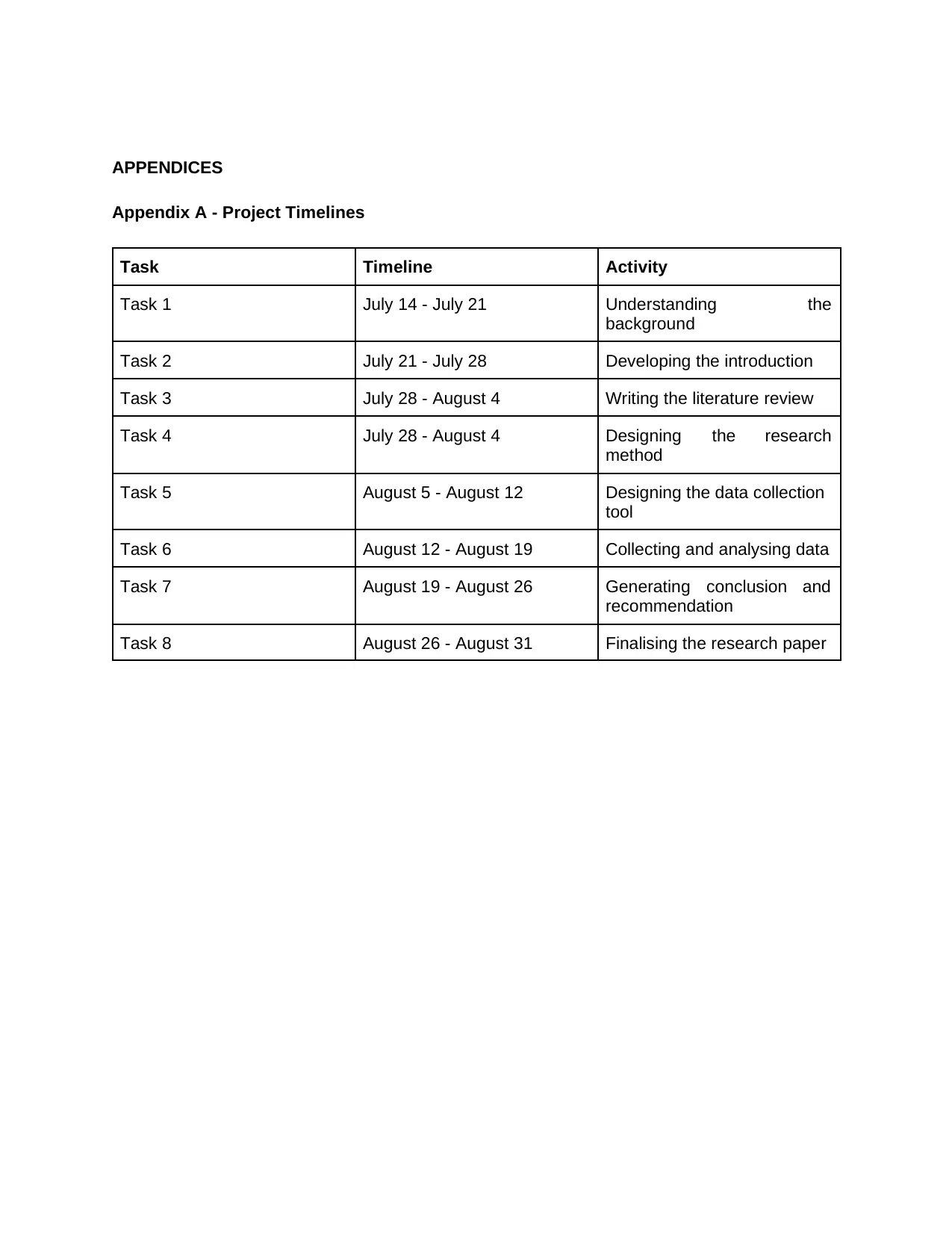
APPENDICES
Appendix A - Project Timelines
Task Timeline Activity
Task 1 July 14 - July 21 Understanding the
background
Task 2 July 21 - July 28 Developing the introduction
Task 3 July 28 - August 4 Writing the literature review
Task 4 July 28 - August 4 Designing the research
method
Task 5 August 5 - August 12 Designing the data collection
tool
Task 6 August 12 - August 19 Collecting and analysing data
Task 7 August 19 - August 26 Generating conclusion and
recommendation
Task 8 August 26 - August 31 Finalising the research paper
Appendix A - Project Timelines
Task Timeline Activity
Task 1 July 14 - July 21 Understanding the
background
Task 2 July 21 - July 28 Developing the introduction
Task 3 July 28 - August 4 Writing the literature review
Task 4 July 28 - August 4 Designing the research
method
Task 5 August 5 - August 12 Designing the data collection
tool
Task 6 August 12 - August 19 Collecting and analysing data
Task 7 August 19 - August 26 Generating conclusion and
recommendation
Task 8 August 26 - August 31 Finalising the research paper
⊘ This is a preview!⊘
Do you want full access?
Subscribe today to unlock all pages.

Trusted by 1+ million students worldwide
1 out of 12
Your All-in-One AI-Powered Toolkit for Academic Success.
+13062052269
info@desklib.com
Available 24*7 on WhatsApp / Email
![[object Object]](/_next/static/media/star-bottom.7253800d.svg)
Unlock your academic potential
Copyright © 2020–2025 A2Z Services. All Rights Reserved. Developed and managed by ZUCOL.


